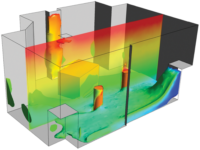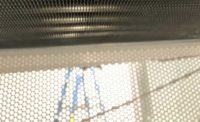Meeting developing code requirements to reduce carbon emissions while creating environments with better IAQ will challenge and impact conventional building HVAC system designs.
In June 2018, the City of Phoenix adopted an amended version of the 2018 International Energy Conservation Code (IECC). The U.S. Department of Energy in July 2021 issued the determination that ASHRAE Standard 90.1-2019 will be the performance standard municipal code authorities are mandated to adopt since it offers from 4% to 5% more energy savings than the 2016 version. On July 1, 2023, the City of Scottsdale put into effect the IECC-2021 code that adopts ASHRAE Standard 90.1-2019 for commercial buildings.
Reducing carbon emissions ascribed to the built environment is essential if our nation and the global community intend to reduce greenhouse gas emissions. It is a widely known fact buildings generate approximately 40% of our nation’s carbon footprint and HVAC systems are responsible for up to 40% of that percentage1. To further demonstrate ASHRAE's commitment to reduce carbon emissions, in the spring of 2021 ASHRAE instituted its Task Force on Decarbonization.
FORM FOLLOWS FUNCTION
To meet the criteria of developing standards and codes, more architects will have to consider an expanded approach to Louis Sullivan’s architectural vision stated in 1896; “form follows function2.” When discussing his firm's architectural process for the new Helios Foundation building, John Kane, principal of the architectural firm Architekton, revealed an adaptive functional design philosophy was adopted that incorporated structural features to optimize overall building performance, but adopted in a manner that did not compromise aesthetics. Many mechanical engineers understand they too will have to examine more closely efficient design strategies for commercial buildings that will challenge centralized all-air heat transfer approaches while minimizing, if not eliminating, the use of on/off and start/stop fan, and compressor cycling. The common practice of calculating energy loads to determine how many nominally rated cooling-only package rooftop units are required to meet loads will be evaluated. More systems will apply modulating technologies such as variable-frequency drives and variable-speed compressors to more effectively “ride” building loads throughout the year. Alternative modes of heat transfer local to building zones will be given wider consideration. Collaboration between architects and engineers will occur more frequently to review how each group’s profession may contribute to reducing building loads while enhancing performance by exploiting material properties and applying the physical laws of passive heat transfer to reduce mechanical work. Taking advantage of more dense heat transfer mediums supplied locally to each zone, otherwise known as decoupled hydronic systems, in lieu of air is a case in point.
Because water is denser than air, it requires less water to move the same amount of energy. This design strategy decouples space sensible and latent loads by driving zone sensible energy to a chilled water loop. Zone-latent load and relative humidity levels (more appropriately, dew point) are controlled by supplying properly dehumidified outdoor air to each space, an optimal design strategy to be applied within the Southwestern U.S. By exploiting the region’s dry climate and designing for annualized performance rather than just peak design conditions, high-performance HVAC is readily attainable, especially when a creative architectural and engineering team work together to meet an owner’s goals.
PROGRAMMNG AND PERFORMANCE REQUIREMENTS
The new building for the Helios Foundation, located in Phoenix, demonstrates what can be achieved when architectural and mechanical engineering firms work together to address programming and performance requirements.
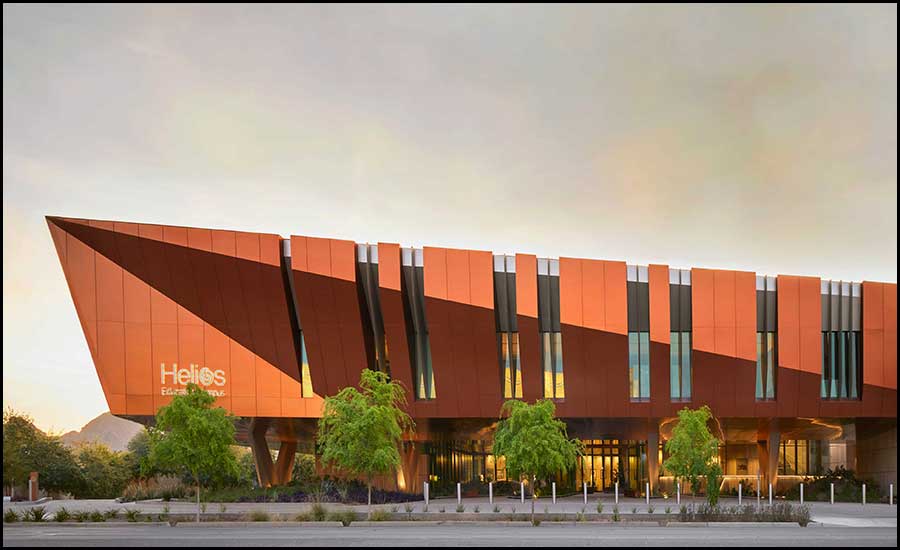
Buildings are not only functional three-dimensional structures with mechanical systems shoehorned into available spaces. Architects can reduce building energy loads by adopting a form-follows-function approach. Applying vertical architectural fins, recessing windows within wall planes and incorporating structural overhangs are attractive and functional building features that serve to reduce direct perimeter solar loads resulting in downsized mechanical systems that consume less energy.
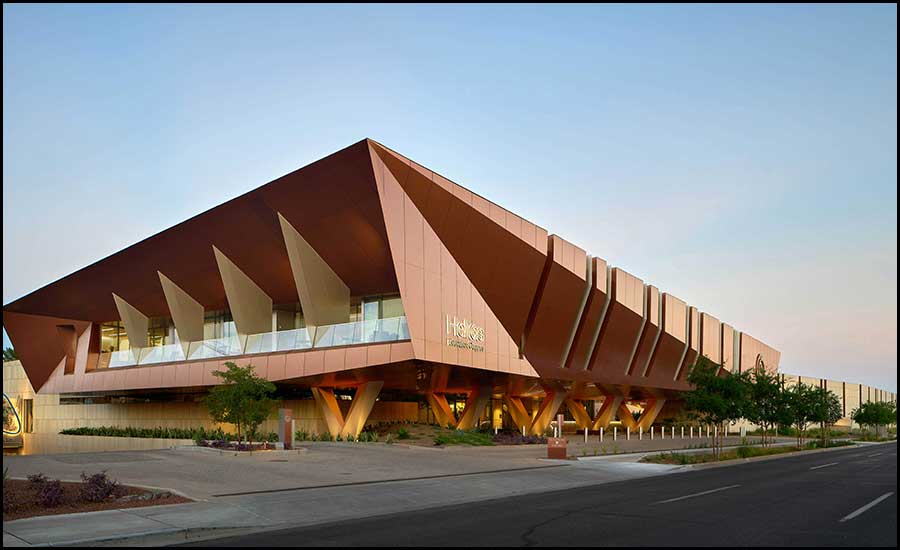
Mechanical engineers can look beyond calculating building loads only to assess how much grid energy is required to meet heat transfer requirements. To visualize the nature of the built environment, one may consider it to be an integrated entity, a reflexive “organism” to internal and external conditions, to respond to and provide vital support to occupants. An HVAC system can be regarded as a building’s cardiovascular system supplying “fresh” air throughout its perimetry to meet thermal comfort and IAQ requirements and, when appropriately designed, to do so efficiently.
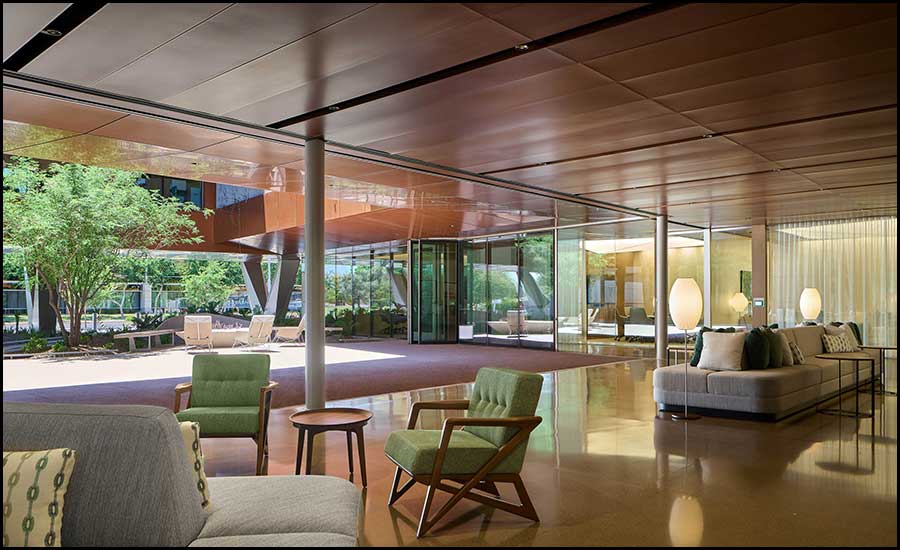
Such a cooperative design approach was adopted by Tempe, Arizona-based Architekton and its Portland, Oregon-based engineering partners PAE for the Helios Foundation. Helios, a nonprofit charitable organization founded to promote, facilitate, and enable post-secondary education for disadvantaged people, needed a new facility to more effectively meet the growing educational needs of disenfranchised youth. Helios’ unique vision extends beyond education. Its mission is to create a culture that will embrace and advance social awareness and the value of education. To meet this objective, the foundation’s building would need to embody formal characteristics to evoke Helios’ core commitments to address educational, social, and environmental needs by creating an open, comfortable and healthy environment conducive to engaging creative dialogue between public and nonprofit educational agencies seeking to make post-secondary education more available to those who lack adequate resources. A large convening area is incorporated into the design for educational seminars and creative programming sessions. Creating an educational sanctuary invites the open exchange of ideas while promoting engagement between these groups.
SITE INFLUENCES STRUCTURE
The building’s chosen site, however, required creative design approaches. Helios’ new structure, considering the required square footage on available acreage, entailed a multi-level platform. However, in respectful concern for neighborhood residents, community dialogue was initiated and ensued, revealing a tall building profile would impact the neighborhood’s intrinsic character and obstruct cherished views of Phoenix’s unique mountainous skyline. Congesting a roof with mechanical HVAC equipment would be aesthetically problematic. To meet Helios’ needs and address community concerns, Architekton and PAE collaborated. Being open to each group’s design requirements, architectural features were incorporated to minimize ambient heat infiltration and solar loads during Phoenix's extreme summer design conditions.
The Sonoran Desert, however, has two summer design conditions. During the months of July, August and most of September, it is common for atmospheric moisture to migrate northward from the Gulf of Mexico, resulting in dew points that can exceed 70◦F. Monsoon conditions with high humidity levels are Phoenix' peak summer design conditions occur during the Monsoon months, not when it is 115◦F at 15% rh.
To meet the owner’s expressed needs and ambitions, PAE’s original mechanical design applied a blended approach of ground-source heat pumps served by dedicated outdoor air units. Since heating demand for the desert is minimal, applying water-source heat pump technology was an appealing option. A passive radiant cooling system was laid out to address supplemental space sensible loads not met by the ventilation component. However, local warm ground conditions required deeper wells to meet thermal exchange requirements, making the first cost-burden prohibitive. The geothermal component was removed and PAE adopted another, more cost effective 100% OSA active chilled beam design using air-cooled chiller technology..
To address Helios' request for an adaptive mechanical system that provided operational latitude to take advantage of fresh air and natural ventilation opportunities when ambient conditions were appropriate, an active chilled beam design offered the necessary flexibility, providing the DOAS units were properly engineered. These units, however, had to be located indoors to meet owner and neighbor requests and to satisfy building height requirements. Cooling coils had to be sized with capacities to meet most of the building latent demand during summer monsoon. DOAS units are normally laid out with enthalpy wheels that offer 70%-80% heat transfer effectiveness. Wheels, however, come in fixed diameters that would raise unit casing heights and, consequently, increase floor-to-floor heights, resulting in a taller building profile that would exceed the line-of-site limits requested by the local community. Sensible plate and frame heat exchangers are used that offered aspect ratio flexibility to reduce unit heights to within tolerance.
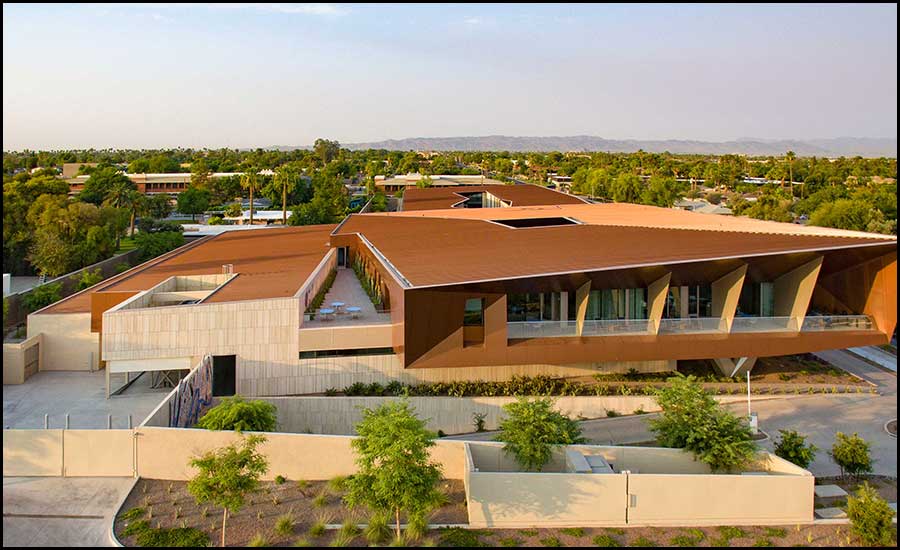
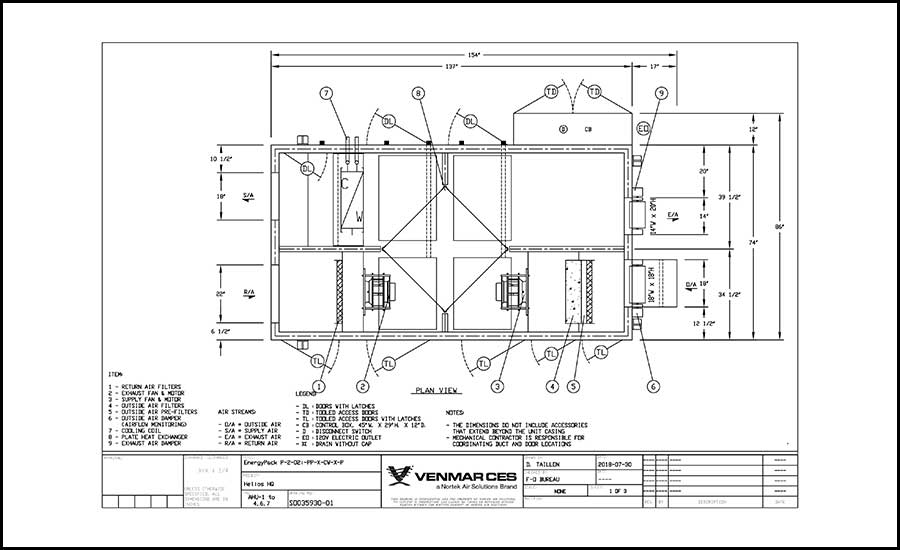
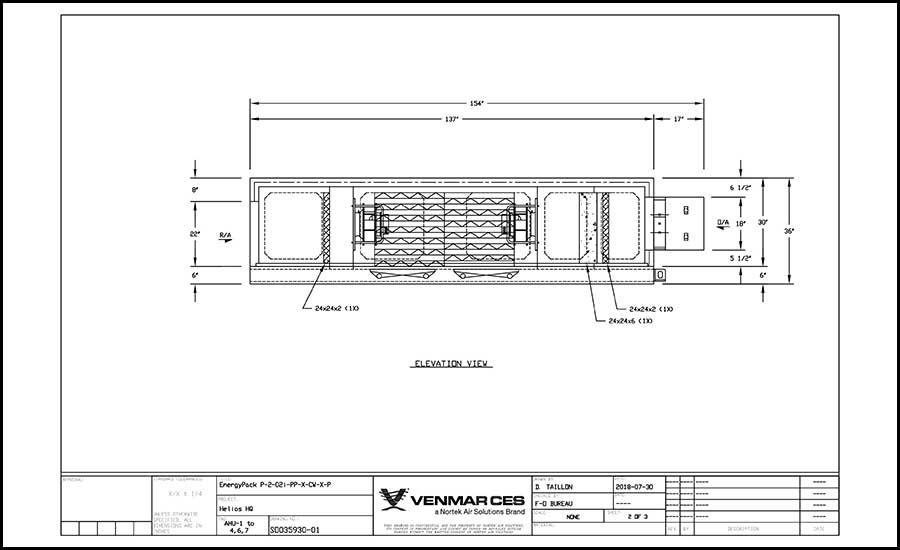
OPEN BUILDING, OPEN DIALOGUE
To facilitate Helios’ goal to have a more open building design to encourage dialogue and engagement between nonprofit partners when weather conditions are appropriate, operable doors and windows were installed to take advantage of our dry cool winter and shoulder months. To meet more humid ambient conditions, sizing DOAS cooling coils for the available cabinet space was necessary. They had to have enough capacity to meet and maintain building latent control to cover operational contingencies during critical monsoon months. To reduce the risk of active chilled beams condensing, PAE took full advantage of ASHRAE Standard 55’s psychrometric comfort range. While the equipment is designed to achieve a space condition of 75◦F at 50% rh (55.13◦F dew point) during summer monsoon, PAE applied high efficiency..conditions during summer monsoon to 75◦F drybulb at 50% rh (55.13◦F dew point), they integrated high-efficiency control sequences to allow for the building to be operated at an elevated dew point threshold, controlling zones to 75◦F at 65% rh (62.45◦F dew point).
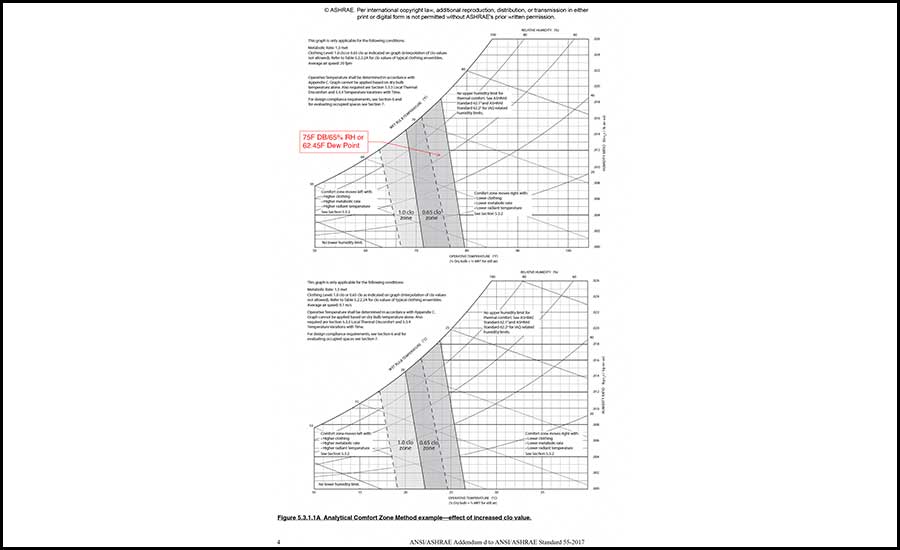
Designing spaces to an expanded comfort range resulted in a higher building rh/dew point levels giving the DOAS cooling coil a broader performance range, enabling energy saving operation year round. A chilled water temperature of 57◦F degrees could be supplied for most of the year resulting in a DOAS coil LAT of 65◦F DB/52◦F WB (41◦F DP). Beam primary air is supplied with an ample 21F dew point depression to each space providing more than adequate building latent control during most of the academic year when the building is fully occupied. One area that posed an engineering challenge was the multipurpose area, otherwise known as the “convening Area.”
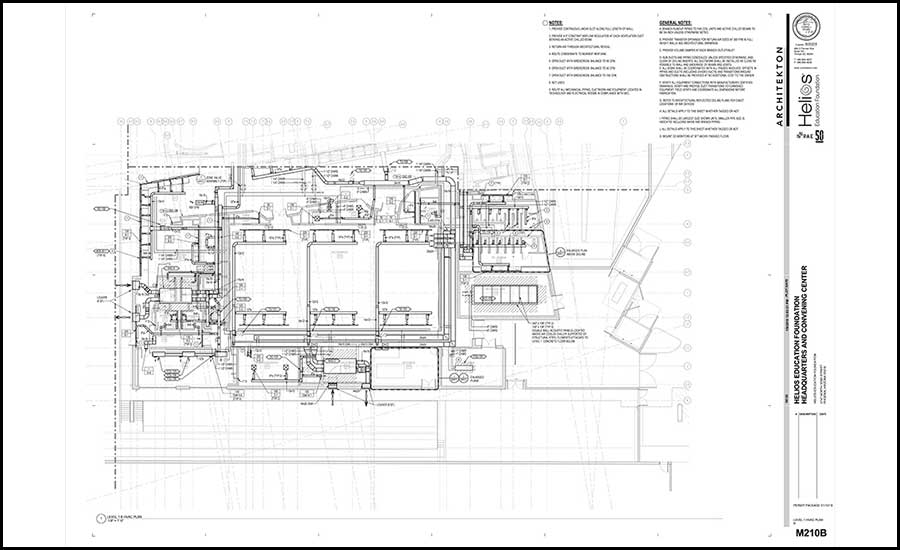
The convening area located within the building’s interior, is designed to seat up to 200 occupants located within the building’s interior. To avoid condensation concerns due to the zone’s high latent component, this area was designed without chilled beams. High-capacity linear diffusers have been provided with adequate air volume to handle both the sensible and latent loads from the occupants. The pre-/post-function zone to the north could also seat the same number of attending occupants before and after events in the convening area. This area is located along the north perimeter wall, an area subject to ambient latent infiltration and occupant moisture loads. Condensing chilled beams are used in this area to meet the additional latent load present on humid days when primary airflow was unable to satisfy. Unoccupied, both spaces relative humidity levels are able to be maintained by low dew point primary air.
Chilled beam chilled water valves will open only when the primary air could not meet sensible load and modulate to maintain space temperature sensible load and modulate dehumidification to the space. Many of the other building zones were designed with operable windows and doors that could be opened during cool, dry days, meeting Architekton’s design intent for access to the outdoors.
Supplying 57◦F chilled water offered another design advantage. At higher leaving water temperatures, chiller performance is optimized inviting the use of high-performance air-cooled chiller technology, an attractive design feature considering our regional drought conditions. However, during monsoon when ambient humidity levels can exceed 70◦F dew point, especially when the building is fully occupied, supplying 57◦F chilled water to a DOAS with a sensible only plate and frame heat exchanger would cause the building to lose humidity control. To meet this design challenge, PAE used a water temperature reset strategy by polling space relative humidity sensors.
When ambient humidity is high and the building’s assigned mean rh level is exceeded, a chilled water temperature reset response is enabled. Chiller LWT is able to be reset to as low as 44◦F, giving the DOAS cooling coil the added capacity to meet building latent loads by delivering 55◦F db / 54◦F wb (53.35◦F dew point) supply air. To maintain simplicity of design, the active chilled beam water loop was also served by 44◦F chilled water turning the devices into condensing chilled beams when ventilation air lacked the capacity to meet zone latent loads. All of the condensation from the chilled beams is captured and routed to the storm water tanks where both water sources are used to irrigate the projects landscape, but only when absolutely necessary.
UNDERSTSANDING CHILLED BEAMS
When chilled beams were introduced into the Phoenix market, many engineers were understandably concerned they would condense and drip water. To let the Helios beams condense, at first, was conceptually problematic, as it went against all intuitive understanding of chilled beam design. Thinking through the concept, it became apparent that buildings are designed regularly with condensing chilled water fan coils. This fact brought forth the awareness that certain types of chilled beams can also be designed as condensing units, but without fans and motors. Selecting an appropriate chilled beam model with vertical coils was required. Standard chilled beam models with horizontal coils were not plausible as drain pans beneath the coil would inhibit room air induction across the coil.
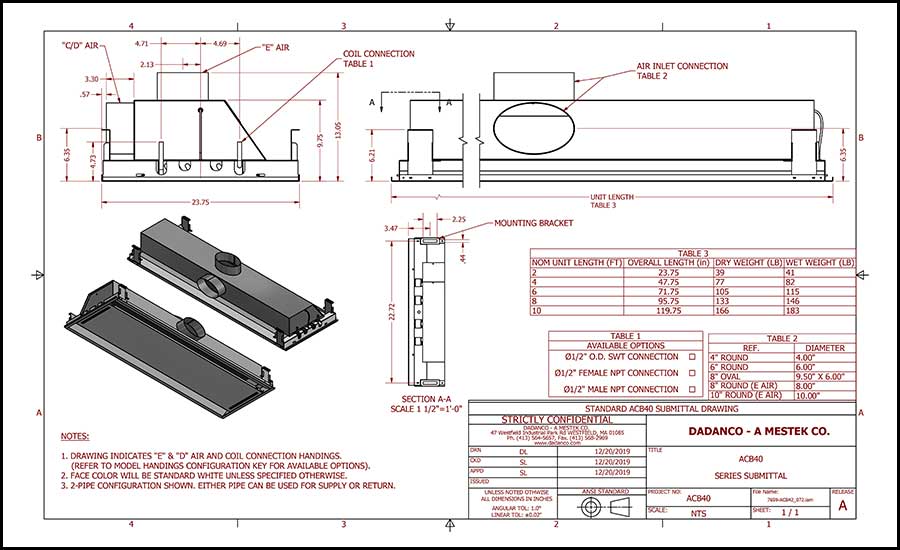
However, most beam manufacturers offer models with vertical coils and either down or horizontal discharge air orientations. Beams with vertical coils can be fabricated with catch or drain pan options installed below.
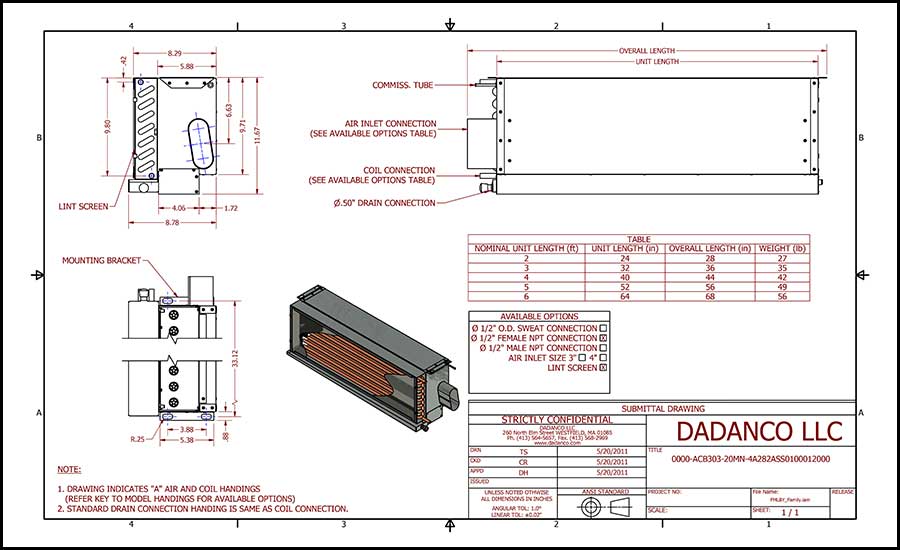
Using vertical coil chilled beams met Helios’ and PAE’s design intent to provide the greatest latitude of performance without building engineers having to resort to manual. to manual override. Primary air serving the beams is constant volume with pressure independent airflow regulators provided in each branch duct to assure proper airflow. When humidistat polling determined building humidity was at design threshold, chilled water temperatures are reset linearly from 57◦F to 44◦F. Recall supplying 44◦F chilled water to the DOAS cooling coil resulted in a supply air condition of 55◦F db/ 54◦F wb or 53.3◦F dew point, a 9◦F degree dew point depression to space set point. Providing beam drain pans also gives Helios the option to open doors and windows during the winter and shoulder season months when ambient conditions were suitable without being concerned about condensation ruining ceilings or furniture. One concern had to be addressed.
Condensing beam coils would allow dust induced over a coil to stick to water droplets that would gradually create a muddy film on coil fins, restrict free area and compromise heat transfer performance. To address this concern, the Helios beams were designed and provided with filters, another factory option, to reduce the amount of dust induced over the coils. Helios’ maintenance team were made aware of this feature during design and of the need to periodically change out filters to minimize coil build up. It is of interest to note that Jeff Wienke, Plaza Companies building manager for Helios, confirmed that after two years of coil operation fowling has not been a maintenance issue.
CONCLUSION
Meeting developing building standards and codes, while assuming best practices to support high-performance buildings, will require architects and engineers to collaborate holistically. Following up with building owners and property management groups should also be considered to make sure systems are performing appropriately and to gain practical wisdom that might be applied for future designs. Wienke confirmed the building is conforming to design intent and meeting the owner’s needs. During peak design days,the chilled water system resets and DOAS coils and chilled beams are served with 44F chilled water. When the building resets the chilled water temperature and DOAS cooling coils and chilled beams are served by 44◦F chilled water, humidity is controlled throughout the building during peak summer design days. After operating for two monsoon seasons, building humidity levels are being controlled and the chilled beam condensate pans are filling with less water than anticipated.
Considering the diverse operational usage of the building, design challenges proposed by the rapid load shifts of the convening area, the open sequestered nature of the interior spaces to serve as sanctuaries to invite creative thought, inspiration and dialogue, it is satisfying to learn building thermal comfort complaints fall far below ASHRAE Standard 55's 20% threshold, an admirable achievement. Architekton’s creatively adaptive and innovative architectural design approach combined with PAE’s commitment to sustainability through sound engineering, the Helios project is meeting, if not exceeding, expectations; a structural statement demonstrating all parties benefit when design groups and owners collaborate to meet owner needs and aspirations with designs that conform to or exceed developing code and standard requirements.
Note:
A special thank you to John Kane, Principal of Architekton, and Jeff Wienke, Plaza Companies, for their generous contribution of time and information regarding the design and operation of the Helios building.
References:
1 The AIA 2030 commitment.The American Institute of Architects. (n.d.).
2 Form follows function. The Guggenheim Museums and Foundation. (n.d.).
3 Standard 55-2017, A. (2020). ANSI/ASHRAE Addendum D to ANSI/ASHRAE standard 55-2017. ashrae.org.





